What?! Tumble weeds and weeds throughout my property? What tumble weeds? I walk my yard at least weekly and pull what I call tumble weeds and weeds. Why did the Fire Department send me this? They can have a contractor remove my “weeds” and send me a bill? What are they calling “weeds?” Does the person who wrote this thing know a tumble weed from a California native plant?
I was very worried that I would be required to get rid of my drought tolerant garden dominated by California native plants in the unirrigated zone of my yard. I was also worried that I would no longer be allowed to use gardening practices critical for converting compacted mineral soil into a productive garden.
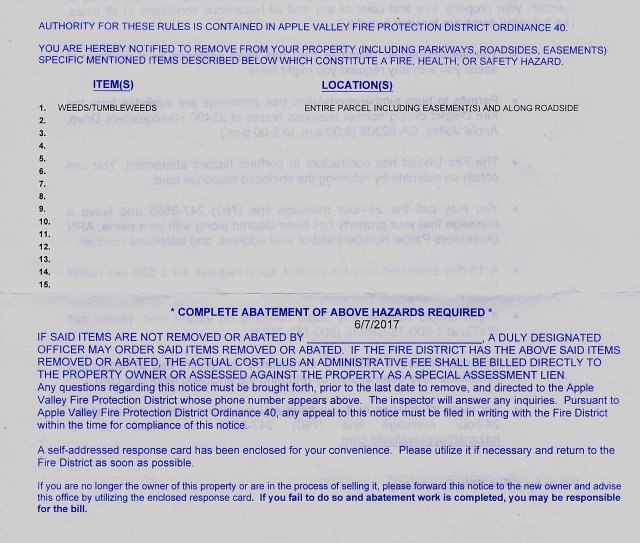
Initial efforts to reach the Town of Apple Valley Fire Department were less than successful. I needed help and fast. So, I sent out an e-mail with attached photos of my yard and a cc to everyone who had a stake in promoting gardening with California Natives.
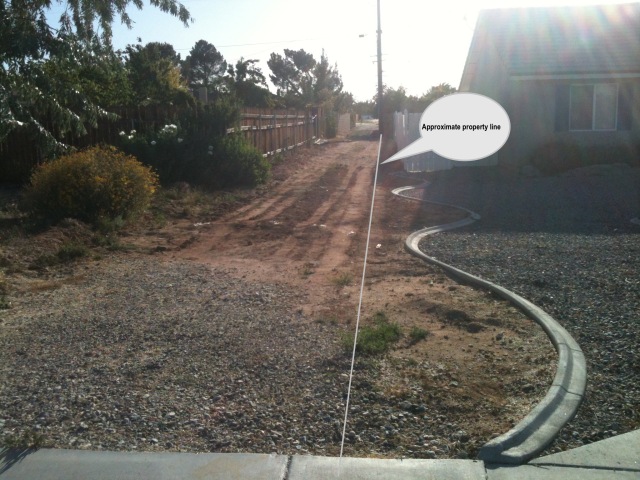
What “Tumble Weeds” and “Weeds Throughout”?
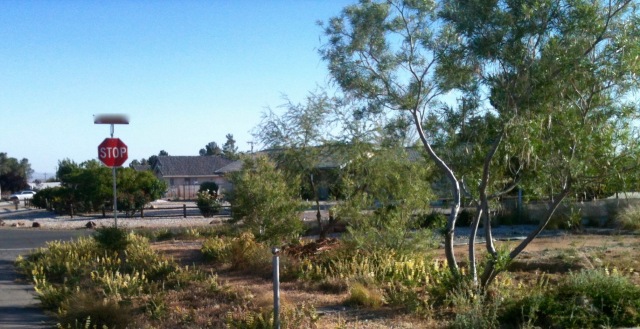
What are they calling “Weeds and Tumbleweeds along roadside?”
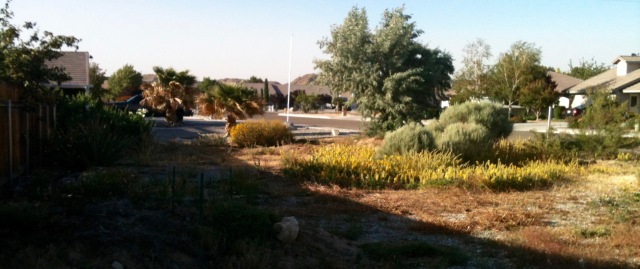
“Tumble Weeds and Weeds Throughout?”
I got prompt responses from California Native Plant Society and best of all the Mojave Desert Resource Conservation District. Chuck Bell, President of Mojave RCD and Neville Slade, Instructor at Agriculture and Natural Resources Department of Victor Valley College offered to organize an onsite meeting with officials from the AV Fire Department. They were interested in helping me because they were getting a lot of similar calls from homeowners with native plants and drought tolerant gardens. In preparation for the meeting, I made a partial list of the natives in my front yard and prepared a spreadsheet with Fire Management Information. I got great help from US Forest Service with accessing online information about fire management of native plants. Chuck Bell studied my photos and recommended that I get rid of drying grasses before the meeting he was organizing for Tuesday afternoon. The list of people Chuck Bell and Neville Slade suggested inviting was growing and getting more illustrious with each exchange of e-mail. OMG. I need to do more than make sure the place is in complete compliance; time to drop everything for some serious spit and polish.
Monday morning my room mate and I were scurrying about sprucing the yard when my room mate came up to me and said, “There is someone here to see you.” I looked up to see a woman decked out in a Fire Department uniform. “I can’t come tomorrow,” she said. “I want to see what you have.” I told her about the spreadsheet that I was preparing. She asked me to e-mail her a copy. She also mentioned that she was looking for ideas for what to plant in her own yard. I was so relieved. She wasn’t going to call all of my native plants “tumble weeds” after all.
So, I gave her a tour of the yard and native plants that I have growing in it. She seemed to genuinely appreciate my beloved plants. The Fire Marshall won me over when she patted my manicured creosote bush (Larrea tridentata) like it was a pet dog.
I brought up some of the challenges such as flooding in the corner, need to create drought resistant soil, and compacted soil resulting from trespassers driving across my front yard. I was solving many of these problems by putting in roadside swales and a rain garden. I also explained how I am using “weeds” as a cover crop to rehabilitate the soil. While accumulated leaf litter from some plants, such as rabbit bush (Ericameria nauseosa, or Ericameria paniculata ) could accumulate to create a fire hazard, accumulation leaf litter from less flammable plants is important for building soil texture, preserving soil moisture, infiltrating rain water, and even weed management. I also showed her berms where plantings died until I put in vertical mulch and litter. Recruitment of “weeds” in these locations was helping improve the soil for successful establishment of landscaping plants.
After she listened and admired my plants, the Fire Marshall explained the notice that I received. It turns out that the wording in the Notice she sent me is driven by language in Ordinance 40 that authorizes her to order the removal of “tumbleweeds and weeds”. Her real concern is dead and dry vegetation that is over four inches high and fuel ladders. Annuals, even pretty wildflowers, can dry out in a day or two. So she includes them in a letter that gives property owners 30 days for removal. If a property owner needs extra time for seeds to mature, a request for a time extension can be granted.
I did have a nice stand of Fiddleneck (Amsinkia sp.) that flocks of finches with yellow bellies were feasting on. As soon as the finches lost interest, I weed whacked and raked out the dried fiddle neck. It was gone by the time her letter arrived. I also had/have some miserable Bromus tectorum L. mixed in with annual lupines that are starting to go to seed. She granted me a two week extension so that I could weed whack it all at once instead of having to hand weed areas where I couldn’t get a weed whacker or small rake in between the lupines. I was relieved and grateful.
The major concerns that she has are:
- Any dead or dry vegetation – even native annuals or spent horticultural plants,
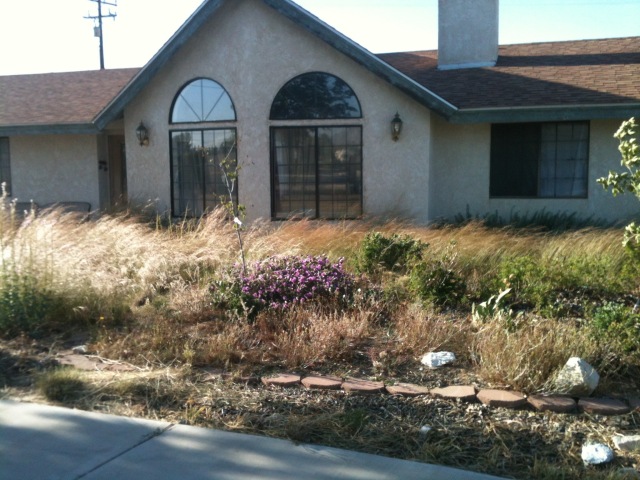
Wildflowers going to seed. The Fire Marshall gave me a two week extension for the seeds to mature, then the dry vegetation must be removed. The purple needle grass in the background will need to be trimmed to four inches for the fire season.
2. Weeds over 4 inches tall,
- Tumbleweeds: aka Russian thistle Salsa tragus,
4 Wild mustards: Brassica nigra, Brassica rapa, Brassica tournefortii,
- Annual grasses such as: Bromus tectorum, Bromus diandrus, Bromus hordeaceus, Bromus madritensis ssp. rubens, Bromus japonicus, Schismus arabicus, and S. barbatus,
- Tamarix species: Tamarix parviflora, Tamarix aphylla, Tamarix ramosissima, T. gallica, and T. chinensis, and
- Arundo donax,
She also was interested in finding out how to identify puncture vine, Tribulus terrestris,
Her visit ended on a very happy note. The meeting planned for Tuesday afternoon is no longer needed. Since the Fire Marshal has recently issued over 2000 letters for weed abatement, I thought I would share the information.
I owe a big thank you to:
Mojave Desert Resource Conservation District, US Forest Service, The California Native Plant Society, Alliance for Water Awareness and Conservation (AWAC), and the Town of Apple Valley.
Some Handy Websites For Researching Flammability of Plants
The following are links to information on flammability of plants. Most of these links were provided to me courtesy of US Forest Service and The Mojave Desert Resource Conservation District.
USFS Fire Effects Information System (FEIS): https://www.feis-crs.org/feis/
http://www.theodorepayne.org/plants/fire_resistant.htm
http://www.laspilitas.com/easy/deerfire.htm
http://www.cnps.org/cnps/conservation/pdf/fire/frem38.2_38.3_schettler.pdf
https://www.fs.usda.gov/rds/archive/Product/RDS-2016-0023/
https://www.fs.usda.gov/rds/archive/Product/RDS-2015-0019/
Publications and paper by R&D scientists within the USDA Forest Service: Treesearch
US Forest Service research data archive: USFS Data Catalog

It sounds like your community is trying to work together and shows lots of flexibility…congratulations.
LikeLiked by 1 person
Thank you. I am grateful for the support that I received from my community.
LikeLiked by 1 person
I’ll find some other “ammo” for you in case you need it! Seems rough of your fire dept, though having “spit and polish” with some strong plant scheme is all it might take. Ornamental grasses are the rage all over, and your Aristida purpurea (?) looks great. More later…
LikeLiked by 2 people
Thanks for your support. I really did enjoy seeing my Nassella pulchra (Hitchc.) Warkworth dancing in the wind. I recently trimmed it back to four inches near the house. More information would be handy when you have a chance.
LikeLiked by 1 person
Good post! It was cool of Neville to organize a meeting . He’s a great guy!
LikeLiked by 1 person
Thank you. I agree that Neville is a great guy! So is Chuck Bell and a lot of other people who helped out. Susan the Fire Marshal turned out to be cool too.
LikeLike
Thank you for your awesome informative post.
LikeLiked by 2 people
You are most welcome.
LikeLike
Thank you for stopping by.
LikeLike
I tried to post a comment but failed. Bummer. This was a great post.
LikeLiked by 1 person
Thank you for stopping by and for your kind words. Your help with the “Spit and polish” is greatly appreciated.
LikeLike